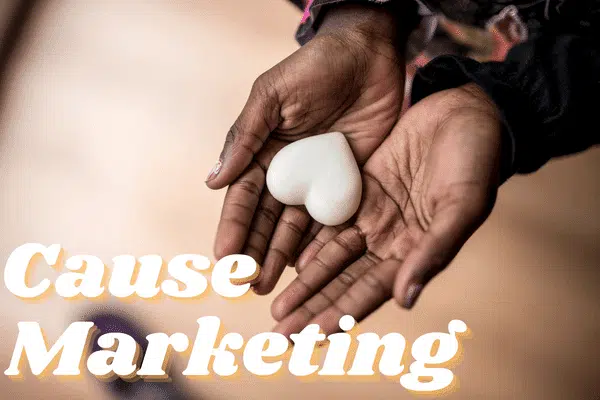Most people think any cause marketing strategy is only for charities and nonprofits. But that’s not true! Cause marketing can be used by any business, large or small, to create a positive impact in the world.
Being socially responsible is essential to today’s consumers, so businesses need to get on board.
Cause marketing is a wonderful way to show your customers that you care about more than just profit – you also care about making a difference in the world.
Continue reading to learn more about how cause marketing can benefit your business and society.
Key Takeaways
- Cause marketing is a collaborative effort between a business and a charity to promote a shared cause, benefiting both by enhancing the company’s brand and providing the charity with exposure and financial support.
- Businesses engaging in cause marketing can experience numerous benefits, including increased brand awareness, community engagement, positive brand association with good causes, demonstration of social responsibility, and ultimately, higher sales and profits.
- Developing a cause marketing strategy involves defining core values, researching and choosing a cause, creating and distributing marketing materials, identifying key partners and ambassadors, and carefully selecting a charity partner to ensure alignment with the company’s values and goals.
What is Cause Marketing?
Cause marketing is a shared interest between a company and a charity, where the two organizations work together to promote a shared cause or social issue.
The relationship benefits both parties. The company gets to show its support for a good cause, and the charity receives exposure and access to new supporters.
In most cases, the company will also financially contribute to the charity. While cause marketing can take many forms, one of the most common is cause-related marketing campaigns, where companies donate a share of their sales to charity.
For example, during October, many businesses will sell products that support breast cancer research, with a portion of the revenue going to charities that focus on fighting the disease.
Cause marketing can be an effective way for companies to build brand awareness and loyalty while also doing a lot of good for the community.
How can Cause Marketing Be Beneficial to Your Business?

There are substantial reasons why your business should consider cause marketing.
Here are five of the most important benefits:
Increased brand awareness, web traffic, and social media following
When you partner with a charity, its supporters learn about your company and what you do. If they are impressed, they’ll be more likely to support your business in the future.
Also, when customers see that you’re supporting a worthy cause, they’ll be more likely to share your content with their friends and followers.
Greater community engagement
Giving back to the community is an impressive way to get your target market involved and engaged with your company.
When they feel part of something bigger, they’ll be more likely to support your business so you can continue to do good work.
Plus, community engagement can lead to increased media coverage, which can also help to raise awareness of your company.
Positive association with a good cause
As we mentioned, consumers are becoming more and more socially conscious. They want to know that the companies they support are also working to make the world a better place.
When you engage in cause marketing efforts, you create a positive association between your brand and the good cause you support. It can lead to an improved company reputation and brand loyalty.
Opportunity to show social responsibility
In today’s business climate, it’s important to show that you’re a socially responsible company. By partnering with a charity and backing a cause, you can demonstrate to your customers that ROI is not all you care about.
Customers are not the only ones who care about corporate giving.
Many employees also want to work for companies making a positive contribution to the world. It can improve employee retention rate and attract and retain top talent.
More sales and profits
When done right, cause marketing ultimately leads to an increase in sales and profits.
Businesses are more likely to partner with companies they perceive as good corporate citizens. In addition, building brand awareness and customer loyalty will create a solid foundation for long-term success.
There you have it! These are just some of the advantages of cause marketing. If you’re looking for a way to create a positive influence while improving your bottom line, cause marketing is a great option.
Types of Campaigns that Can Be Used in a Cause Marketing Strategy

Now let’s look at different campaigns you can use as part of your strategy.
Awareness Campaigns
An awareness campaign is a marketing initiative focusing on increasing visibility and understanding of a particular cause or issue. These campaigns can be advertising, social media marketing, or public relations initiatives.
In most cases, the goal of an awareness campaign is to get more people talking about the cause or issue to generate support for it.
Businesses can use awareness campaigns to support various causes, such as environmental protection, social justice, or disease prevention. In many cases, these campaigns are launched by nonprofit organizations or NGOs.
However, for-profit companies can also launch awareness campaigns as part of their corporate social responsibility initiatives.
Some successful awareness campaigns include the ALS ice bucket challenge, which went viral on social media and helped to increase the visibility of the disease, and the Nike “Just Do It” campaign, which raised awareness of the importance of physical activity.
Issue-Based Campaigns
An issue-based campaign focuses on raising awareness and understanding of cases like climate change, poverty, inequality, and other social and environmental issues.
It generally involves partnering with a corporation or nonprofit organization committed to the cause.
The goal of issue-based cause marketing campaigns is not only to raise awareness about the issue at hand but also to generate support and funding for the organizations working to address it.
A good example of a successful issue-based campaign is the “Live Below the Line” campaign, which raises awareness of global poverty.
Collaborative Campaigns
A collaborative campaign involves multiple businesses working together to support a common cause. This type of campaign is often used to increase the cause’s visibility and generate more donations.
An example is the “Red Nose Day” campaign, an annual event raising money for poverty relief. Multiple businesses participate by donating a portion of their proceeds to the cause.
Thematic Campaigns
A thematic campaign centers on a specific theme, such as breast cancer awareness or water conservation. This type of campaign generally involves producing marketing materials (e.g., ads, social media posts, etc.) that feature the chosen theme.
An example is the “Pink Ribbon” campaign, which raises awareness about breast cancer.
Event-Based Campaigns
Event-based campaigns are marketing initiatives that revolve around a particular event, such as a concert, gala, or race. These campaigns are often used to raise money for a specific cause.
One of the marketing examples is the annual Livestrong Challenge, a cycling event that raises money for cancer research. The event includes different routes people can choose, depending on their ability level.
Digital Campaigns
Digital campaigns are marketing initiative that uses digital channels to reach their target audience. These campaigns include online advertising, social media outreach, email marketing, franchise advertising, and website content.
Digital campaigns are a terrific way to reach a large audience with your cause marketing message. They’re also relatively easy and inexpensive to launch. Some successful digital campaigns include the Kony 2012 campaign, which used social media to raise awareness about the atrocities perpetrated by the Lord’s Resistance Army in Uganda.
At this point, you already have the background information that you need to develop your own cause marketing strategy.
Steps for Developing a Cause Marketing Strategy

A cause marketing strategy requires careful planning and execution. You’ll need to take a few key steps to develop a successful plan.
Step 1: Define Your Core Values
Your company’s core values are the beliefs that guide your business decisions. Your marketing initiatives, including your cause marketing strategy, should be reflected in them.
You must be clear on what you want to stand for and your purpose. What causes are important to you and your employees? What issues do you care about? Answering these questions will help you determine which causes you might want to support.
Step 2: Research Causes
Now that you know the causes your company might want to support, it’s time to do some research. You’ll want to find a cause that is important to your target company and aligns with your company’s values.
To get started, you can use a cause marketing platform like ioby or CauseVox. These platforms allow you to search for causes by location, issue area, or keywords.
You can also use Google. Just enter a keyword related to the cause you’re interested in, such as “breast cancer” or “poverty,” followed by “near me.” It will give you a list of organizations working on the issue in your area.
Step 3: Create Marketing Materials
Once you’ve selected a cause, it’s time to develop marketing materials that communicate your company’s values and the cause you’re supporting. These materials should communicate your company’s values and the cause you’re supporting.
Some examples of marketing materials include:
- social media posts
- blog articles
- videos
- infographics
- flyers
These materials will help you raise awareness about the cause you’re supporting and encourage people to take action.
Once you’ve created your marketing materials, it’s time to start distributing them. Your distribution method depends on the type of material you’ve made. If you’ve created social media posts, you can share them on your company’s social media channels.
If it’s a blog article, post it on your website or submit it to a relevant blog directory. And if you’ve created a video, there are YouTube and other video-sharing sites.
You can also use paid media to have a wider reach. For example, you can use Google AdWords to display your video on YouTube or Facebook ads to promote your blog article.
Step 4: Identify Key Partners and Ambassadors
The key partners and ambassadors for your campaign are people who can help you reach a larger audience and make a bigger impact.
These people may have a large social media following, be influencers in their field, or have a platform that can reach a wide audience.
Some examples of key partners and ambassadors for a cause marketing campaign are:
- celebrities
- social media influencers
- journalists
- bloggers
- podcasters
- YouTubers
- local businesses
- community leaders
When choosing a partner or ambassador, see to it that there is alignment between the values of your organization and the values of the potential partner or ambassador.
Choose a partner or ambassador who is passionate about your cause and who will be committed to promoting your campaign.
Step 5: Launch and Promote
Promote your campaign through social media, affinity marketing, email marketing, and other channels to get the word out. Encourage people to take action by sharing your campaign on social media using a hashtag or asking them to sign up for your email list.
You can also promote your campaign through paid advertising.
Your campaign should have a clear call to action that tells people what you want them to do. For example, you might ask people to donate to a specific organization, sign a petition, or write to their elected officials.
Make sure to thank people for taking action and keep them updated on your campaign results. It will help build relationships and encourage people to take action in the future.
There go your five steps to create a cause marketing campaign that will make a difference! Keep in mind that it takes time and effort to plan and execute a successful campaign. But with the right strategy, you can make a significant impact.
There’s one more thing to care about: choosing a charity. Here are some tips on how to pick a cause your company can get behind:
How to Choose the Right Charity Partner for Your Campaign?

Choosing the right charity partner for your campaign is just as crucial as executing the campaign itself. The wrong advocacy partner can sabotage your efforts and damage your company’s reputation.
So how do you choose the right partner?
Define what you hope to gain from a charity partnership
When you work with a charity, you need to figure out what you want to get out of it. What do you want the charity to do for you?
Do you want the charity to help promote your campaign? Do you need help in providing volunteers for your event? Or do you simply want to make a donation to the charity?
Answering these questions will help you narrow down your list of potential charities.
Set some criteria and ask the right questions
Once you know what you want to get out of a charity partnership, you can start setting some criteria for your decision. Here are the basic questions to ask when vetting potential charities:
- What is the charity’s mission?
- What are the charity’s values?
- What does the charity do?
- How does the charity spend its money?
- What are the charity’s results?
- How will the charity partner with you?
- What are the charity’s goals for the partnership?
These questions will help you determine if a charity is a good fit for your campaign.
Reach out to the charities that meet your criteria
Once you’ve narrowed your list of potential charities, reach out to them and ask if they’re interested in partnering with you. When you contact the charities, be clear about what you expect from the partnership.
It will help prevent miscommunication down the line. You can also request referrals from other businesses or organizations that have worked with the charities.
Negotiate a contract that outlines expectations and responsibilities for both parties
Once you’ve chosen a charity, it’s time to negotiate a contract. This contract should lay out the expectations and responsibilities of both parties. It should also include a provision that allows either party to end the partnership if it’s not working out.
The contract should also include:
- the duration of the partnership
- how often you’ll communicate
- what publicity you’ll provide for the charity
- what promotional activities will the charity do
- how you’ll measure success
- any financial commitments
By taking the time to choose the right charity and negotiating a contract, you can create a successful cause marketing campaign that will achieve your goals and create a positive change where it matters.
Conclusion
Strive for a cause marketing strategy that is both impactful and sustainable. While there are different methods to approach cause marketing, we believe that the most effective strategies focus on long-term relationships and building trust between brands and consumers.
At its core, cause marketing is about aligning your brand with a significant cause to your target audience. It’s about more than just issuing a check or donating products – it’s about creating a meaningful connection between your brand and the cause.
FAQs
Here are other questions about cause marketing that we have not discussed in the article.
Donating money is a great way for a company to show its dedication to supporting a particular cause and can help create a strong bond between the company and the cause. However, a for-profit business or nonprofit organization can choose not to donate money. Instead, they can focus on raising awareness for the cause or brainstorming new ways to help support it. Either approach can be effective, so it’s up to the company and the cause to decide what would work best.
Yes, a company’s product can absolutely be used as the centerpiece of a cause marketing campaign. For example, Toms Shoes has been very successful in marketing its shoes as a way to help provide shoes for children in need. In this case, the product is part of the cause marketing campaign.
There are no restrictions on what type of charities can be partnered with for cause marketing. However, you must verify that the charity is reputable and that the cause is something that aligns with the company’s values.